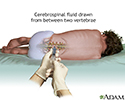CSF glucose test
Glucose test - CSF; Cerebrospinal fluid glucose testA CSF glucose test measures the amount of sugar (glucose) in the cerebrospinal fluid (CSF). CSF is a clear fluid that flows in the space surrounding the spinal cord and brain.
How the Test is Performed
A sample of CSF is needed. A lumbar puncture, also called a spinal tap, is the most common way to collect this sample.
Lumbar puncture
Cerebrospinal fluid (CSF) collection is a test to look at the fluid that surrounds the brain and spinal cord. CSF acts as a cushion, protecting the b...

Other methods for collecting CSF are rarely used, but may be recommended in some cases. They include:
- Cisternal puncture
- Ventricular puncture
- Removal of CSF from a tube that is already in the CSF, such as a shunt or ventricular drain
The sample is sent to a laboratory for testing.
Why the Test is Performed
This test may be done to diagnose:
- Tumors
- Infections
- Inflammation of the central nervous system
- Delirium
- Other neurological and medical conditions
Normal Results
The glucose level in the CSF should be 50 to 80 mg/100 mL or 2.77 to 4.44 mmol/L (or greater than 2/3 of the blood sugar level).
Note: Normal value ranges may vary slightly among different laboratories. Talk to your health care provider about the meaning of your specific test results. Results can also be affected by your serum glucose level, especially if levels are extreme.
The examples above show the common measurements for results for these tests. Some laboratories use different measurements or may test different specimens.
What Abnormal Results Mean
Abnormal results include higher and lower glucose levels. Abnormal results may be due to:
- High blood sugar (hyperglycemia)
- Infection (bacterial or fungus)
- Inflammation of the central nervous system
- Tumor
References
Deluca GC, Griggs RC. Approach to the patient with neurologic disease. In: Goldman L, Schafer AI, eds. Goldman-Cecil Medicine. 26th ed. Philadelphia, PA: Elsevier; 2020:chap 368.
Euerle BD. Spinal puncture and cerebrospinal fluid examination. In: Roberts JR, Custalow CB, Thomsen TW, eds. Roberts and Hedges' Clinical Procedures in Emergency Medicine and Acute Care. 7th ed. Philadelphia, PA: Elsevier; 2019:chap 60.
Rosenberg GA. Brain edema and disorders of cerebrospinal fluid circulation. In: Jankovic J, Mazziotta JC, Pomeroy SL, Newman NJ, eds. Bradley and Daroff's Neurology in Clinical Practice. 8th ed. Philadelphia, PA: Elsevier; 2022:chap 88.
Lumbar puncture (spinal tap) - illustration
A lumbar puncture, or spinal tap, is a procedure to collect cerebrospinal fluid to check for the presence of disease or injury. A spinal needle is inserted, usually between the third and fourth lumbar vertebrae in the lower spine. Once the needle is properly positioned in the subarachnoid space (the space between the spinal cord and its covering, the meninges), pressures can be measured and fluid can be collected for testing.
Lumbar puncture (spinal tap)
illustration
Lumbar puncture (spinal tap) - illustration
A lumbar puncture, or spinal tap, is a procedure to collect cerebrospinal fluid to check for the presence of disease or injury. A spinal needle is inserted, usually between the third and fourth lumbar vertebrae in the lower spine. Once the needle is properly positioned in the subarachnoid space (the space between the spinal cord and its covering, the meninges), pressures can be measured and fluid can be collected for testing.
Lumbar puncture (spinal tap)
illustration
Review Date: 4/29/2023
Reviewed By: Joseph V. Campellone, MD, Department of Neurology, Cooper Medical School of Rowan University, Camden, NJ. Review provided by VeriMed Healthcare Network. Also reviewed by David C. Dugdale, MD, Medical Director, Brenda Conaway, Editorial Director, and the A.D.A.M. Editorial team.


